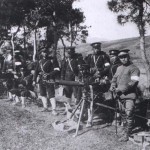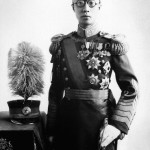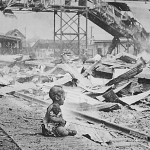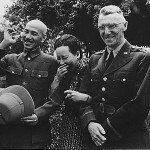
The Second Sino-Japanese War (1937-45) had a significant impact on the course of the Chinese Revolution. Known in China as the ‘War of Chinese People’s Resistance Against Japanese Aggression’, it was a catastrophic conflict for the Chinese people, causing up to 20 million casualties. It also had serious political repercussions for the nationalist Guomindang and the Chinese Communist Party (CCP). Japan’s invasion of China in the early 1930s and the war that followed capped off decades of antagonism between the two nations. The political and economic development of Japan stood in stark contrast to that of China. The Meiji Restoration of the late 19th century had propelled Japan into the modern world. The Japanese had tapped into Western knowledge to develop an industrialised economy. Japan’s military, once a barefoot army of samurai, was now a well trained Westernised armed force, equipped with modern weapons. Its government was dominated by militarists and expansionists who hoped to make Japan an Asian imperial power.
The First Sino-Japanese War erupted in August 1894 over control of the Korean peninsula. This war ended with a Japanese victory in a little over eight months, despite Japanese forces being greatly outnumbered by the Qing armies. The Treaty of Shimonoseki, signed in April 1895, saw China surrender control of the Liaodong peninsula, west of Korea, and the island of Taiwan. Six years later, following the disastrous Boxer Rebellion, Japan won the right to station troops in eastern Manchuria, giving them a military stronghold on the Chinese mainland. The collapse of the Qing dynasty in 1911 allowed Japan to further expand its sphere of influence in China. In 1915 the Japanese government issued Chinese president Yuan Shikai with a set of 21 territorial and concessional demands, which Shikai had no choice but to accept. An incident in Mukden, Manchuria in September 1931 provided the Japanese with the pretext for a full military invasion of Manchuria. Once established there, the Japanese set up the puppet state of Manchukuo and installed the last Qing emperor, Puyi, as its ineffectual head of state. In May 1933 the Nationalist president Jiang Jieshi, who was more concerned with fighting the communists than Japanese imperialists, signed the Tanggu Truce, effectively recognising the legitimacy of the Manchukuo puppet state.

Full-scale war between China and Japan began in July 1937, following an incident near the Marco Polo Bridge in Wanping, near Beijing. After Japanese troops opened fire on local soldiers a brief ceasefire was negotiated, however, both sides increased military numbers in the region. When the Japanese launched an invasion in late July, the Nationalists and CCP were seven months into a shaky alliance, dubbed the Second United Front. The Nationalist armies attempted to resist the invasion but were quickly overcome by the technological supremacy and preparedness of the Japanese. China’s underdeveloped industries were incapable of supplying munitions or engineering quickly or in sufficient quantities. Unlike the Japanese, the Chinese military had no tanks and only a few aircraft. The first phase of the war was a blitzkrieg of Japanese victories as their forces moved swiftly along China’s east coast. Almost a half million Japanese troops moved against Shanghai, Nanjing and other locations in mainland China, while Japanese military planes bombarded regions where their foot soldiers could not penetrate. In late 1937 the Nationalist government was forced to retreat from its capital, Nanjing, to Chongqing in western China.

Japanese troops were notorious for their brutal treatment of civilians and military prisoners. The Japanese occupation of Nanjing from December 1937, often referred to as the ‘Rape of Nanjing’, is the most infamous example of Japanese brutality in China. Estimates suggest that the Japanese massacred 300,000 people in and around the city, many of them civilians. Historian Jonathan Fenby describes the Rape of Nanjing as a uniquely “urban atrocity” because of “the way the Japanese went about their killing, the wanton individual cruelty, the reduction of the city’s inhabitants to the status of sub-humans who could be murdered, tortured and raped at will”. Thousands of civilians were buried alive, machine-gunned or used for bayonet practice. Females were taken and forced into labour as “comfort women” (sex slaves for Japanese officers and soldiers). The Japanese also conducted human experimentation in secret bases in China. Unit 731 in the country’s northeast was the largest biological and chemical warfare testing facility. Prisoners there were injected with diseases like anthrax, smallpox, cholera, dysentery and typhoid. Other experiments studied the effects of food deprivation and extreme cold; amputation without anaesthesia; and the effects of chemical weapons and flamethrowers. The Japanese also air-bombed cities like Ningbo and Changde with fleas carrying bubonic plague. Vast swathes of China were decimated by Japan’s ‘scorched earth’ warfare, epitomised by the slogan “kill all, loot all, destroy all”.
While Jiang Jieshi had some early assistance from Soviet Russian leader Joseph Stalin, the Nationalists had little support from foreign powers. In June 1938 Jiang ordered the dykes of the Yellow River dam to be blown, a desperate attempt to slow the advance of the Japanese invasion. While this ploy worked, it also caused a devastating flood that killed between 500,000 to one million Chinese civilians, rendered up to ten million homeless and ruined millions of acres of important farmland. The resulting food shortages, famine and human suffering only contributed to rising peasant hatred of Jiang Jieshi and the Nationalist regime. Other problems confronting Jiang and the Guomindang government were widespread corruption, rising inflation and high desertion rates caused by poor treatment of Nationalist soldiers, most of whom were unwilling conscripts.
Beyond 1938 the Sino-Japanese war reached a virtual stalemate. China’s geographical size, her lack of infrastructure and scattered pockets of resistance all helped to slow the Japanese advance. By 1940 the Japanese controlled the entire north-eastern coast and areas up to 400 miles inland. They installed a puppet government in Nanjing under Wang Jingwei, a former Guomindang leader and political rival to Jiang Jieshi. Foreign assistance for the Chinese finally came after the Japanese bombing of Pearl Harbour in December 1941. As the United States was drawn into World War II, China became an important theatre in the war against the Japanese. In 1942 US general Joseph Stillwell was sent to China to assist with training, reorganisation and equipment. Jiang’s authoritarianism, however, hampered their collaboration. Jiang’s wife Soong Meiling, dubbed “Madame Chiang” by the Western press, proved a more skilled diplomat than her husband; she was instrumental in securing some foreign assistance.
“The Nationalist government, which bore the major brunt of the fighting, was so depleted physically and spiritually that it was manifestly incapable of coping with the new challenges of the postwar era.”
Immanuel Hsu, historian
During its war with the Japanese, the CCP continued to consolidate its base in Yan’an, while the Red Army – later reorganised into the Eighth Route Army and the New Fourth Army – defended the inland areas of the northwest. The Japanese had no desire to occupy rural areas in the interior, which created a misleading perception that the communists were successful defenders. Favourable reports from foreign visitors also came out of the Yan’an Soviet during the war period, such as praise from the American Dixie Mission of 1944 and from US president Franklin Roosevelt’s special emissary, Patrick Hurley. Zhou Enlai also became well respected among diplomats and foreign journalists. These factors were exploited by CCP propaganda, which helped generate support for the party and allowed it to present as an alternative national government to the Guomindang. By 1942 CCP membership had grown to 800,000, a twentyfold growth from the beginning of the war five years earlier. Scholars like David Goodman suggest the CCP’s tactics during this period were an essential element of the party’s eventual rise to power.

The Second Sino-Japanese War came to an end in August 1945, after the United States detonated nuclear weapons over Hiroshima and Nagasaki. Russian troops invaded from the north and suppressed Japanese forces in Manchuria, while Japanese forces in China were ordered to surrender to Jiang Jieshi and the Nationalists. In assessing the impact of the war, historian Jonathan Fenby describes it as “an extended body blow for a regime already shot through with weaknesses. The length, scale and nature of the conflict had debilitated China and the Nationalists”. China emerged from the war politically unsettled, economically exhausted and scarred by an enormous amount of human suffering. With the CCP growing in size, popularity and prestige, and the Guomindang government grossly unpopular, the Chinese stage was now cleared for a civil war between the Nationalists and the communists.

1. The Second Sino-Japanese War had its roots in decades of tension between the two nations. In contrast to the modernised and highly militarised Japanese, Chinese republican forces lacked training, equipment and a strong industrial base.
2. Already with a foothold in northern China, and armed with superior military technologies, the Japanese invaded in July 1937. They rapidly occupied the east coast of China in 1938-39.
3. The Japanese used inhumane and sadistic methods during their occupation of China, typified by events like the Nanjing Massacre and their use of human experimentation.
4. Jiang Jieshi was widely criticised for his wartime leadership, for placing more importance on the struggle against the communists than the Japanese. He also led a corrupt government plagued by economic issues and failed to work effectively with China’s foreign allies.
5. The war left the Nationalist government in a vulnerable position, while the CCP managed to consolidate and expand their support, placing them in a more favourable position as China moved towards civil war.
© Alpha History 2018. Content on this page may not be republished or distributed without permission. For more information please refer to our Terms of Use.
This page was written by Rebecca Cairns. To reference this page, use the following citation:
R. Cairns, “The Second Sino-Japanese War, Alpha History, accessed [today’s date], https://alphahistory.com/chineserevolution/sino-japanese-war/.
This website uses pinyin romanisations of Chinese words and names. Please refer to this page for more information.
